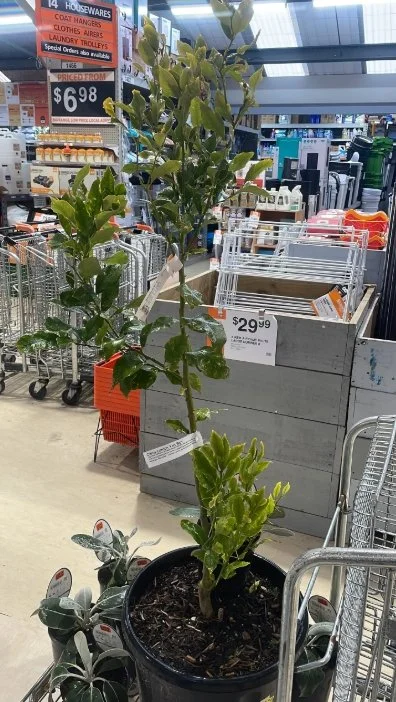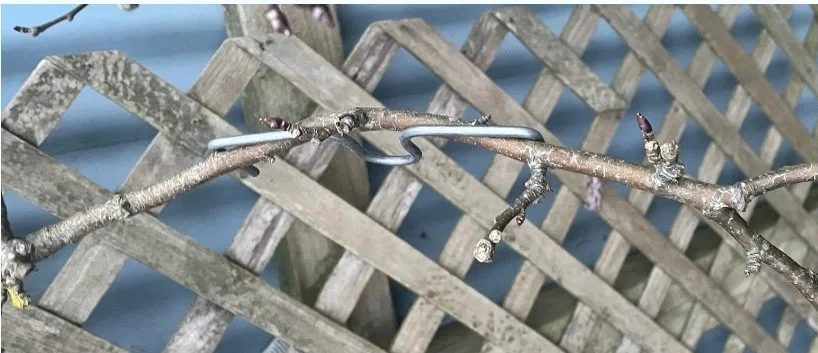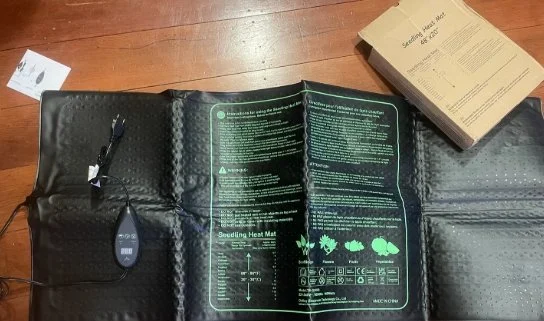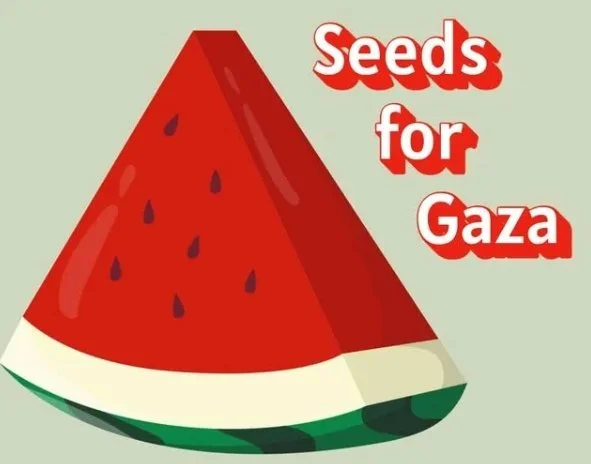Seeds for Gaza and too much time on Aliexpress
What a week for buying things.
I know this is not a shopping blog BUT
Check out this $50 yen ben lemon tree from Mitre 10, marked down from $200- it is about 1.5m high! In the same shop I found a similarly sized bay laurel tree for $35- which will exactly fit the gap left by one which died in a hedge. I had told the client she could choose between a $15 option or a $225 option, and she chose $15- I am going to plant the huge one and give her a scare, thinking her bill will be double… (not actually sure that is a good idea! I will think on it).
And in all of the rains, I did a lot of aliexpress ordering (shout out to Karen in Miramar, a member of the ‘see if it is on aliexpress’ family). We keep losing our hook weeders, which are basically just a piece of wire. Aliexpress don’t have them, unfortunately, but they do have almost every weird thing which has been advertised to me on instagram over the years so I thought stuff it, I’ll get it all.
These bend branches to go in the direction you want. It is useful for fruit trees, because they are more likely to fruit if the branches are parallel to the ground…
The largest one only works on something around the width of a pencil, but I would get the large ones again.
Also- aliexpress sell the large seedling heat pads. Mine died a few weeks ago and I use it to keep my orchids happy- so I got one too. Unsurprisingly it is identical to every single other one I could find based in NZ, and half the price. I just can’t feel bad about buying things from aliexpress when my other option is to buy things from aliexpress…off someone else who bought them from the same factory and are charging a markup. I’d really like to save my money for people who developed the products themselves, or at least made them themselves..
I am not affiliated with Aliexpress! I just spent an entire day not gardening this week and had to share.
I am stoked. I got a bunch more things, specifically secateur replacement parts, but it is too early to tell if they are any good and I didn’t have a good photo.
Seed fundraiser!
The ever-fantastic Philip Wills has set up a Seeds for Gaza fundraiser, where you can get your Spring seeds for an extremely cheap price ($2/ packet) with $1 per packet being donated to The Sameer Project, which importantly has been set up by Palestinians who have feet on the ground (no more worrying about where and how your money is getting in).
Naturally I ordered far too many seeds, but these varieties are bomb, I want to try Pigeon Pea, and it is as good a time as any to stock up on things I use heaps of like Basil… Support a good cause and order some seeds! He is taking orders until Friday, September 5th.
Put your orders in to willstutor@gmail.com - $2 per packet and $5.40 postage. Options are-
Peas - Greenfeast (24 seeds)
Snow pea - Goliath (24 seeds)
Runner bean - Cobra (12 seeds)
Dwarf bean - Borlotto Fire Tongue (12 seeds)
Pigeon pea - perennial legume (10 seeds)
Kale - Tuscan Black (50ish seeds)
Kale - Noble (50ish seeds)
Perpetual spinach - Organic (20ish seeds)
Silverbeet - Rainbow lights (20ish seeds)
Carrot - Tendersweet (200ish seeds)
Broccoli - Waltham - Organic (50ish seeds)
Lettuce - Tom thumb (100ish seeds)
Spring Onion - Tokyo Long White - Organic (100ish seeds)
Mesclun mix (½ tsp seeds)
Rocket - Organic (100ish seeds)
Coriander (50ish seeds)
Watercress (100ish seeds)
Cucumber - Tendergreen - Organic (6 seeds)
Zucchini - Cocozelle (6 seeds)
Zucchini - Black beauty - Organic (6 seeds)
Tomato - Matt's Wild Cherry (6 seeds)
Tomato - Cherokee purple (6 seeds)
Tomato - Yellow pear (6 seeds)
Tomato - Speckled roman - Organic (6 seeds)
Tomato - Beefsteak select - Organic (6 seeds)
Basil - Green - Organic (50ish seeds)
Basil - Red Opal - Organic (50ish seeds)
Capsicum - Red California Wonder - Organic (6 seeds)
Eggplant - Black Beauty - Organic (6 seeds)
Chilli - Cherry (6 seeds)
One more time- put your orders in to willstutor@gmail.com - $2 per packet and $5.40 postage.
What I am obsessed with this week
I can’t write this any better than the author at Crime Pays but Botany Doesn’t, so I am going to copy paste a key part and urge you to read the whole writeup (it is on Facebook, but you don’t need Facebook to see it)-
Like animals, plants respire. This means they burn sugars to create new tissue as well as the chemical compounds they use to defend themselves against fungi & insects, as well as simply to conduct daily metabolic processes required for survival.
“Compensation Point” refers to the light intensity or CO₂ concentration at which the rate of photosynthesis exactly equals the rate of respiration in a plant. At this point, there is no net gain or loss of carbon—the CO₂ absorbed during photosynthesis is equal to the CO₂ released during respiration, and the oxygen produced matches the oxygen consumed.
For a plant to grow (not just survive), it must operate above its compensation point…
Below the compensation point, and operating at a carbon deficit, the plant burns stored energy reserves and eventually dies. Along the way it will decline in health and will gradually become weaker and more prone to insect infestations and fungi.
…plant metabolism is dependent on temperature, something I've repeated many times in videos. In areas where the nights remain warm (because the air is humid and contains water vapor…which is slow to let go of heat), the plant’s metabolism will run at an accelerated rate at night.
So essentially, warm nights mean the plant burns more stored carbohydrates (sugars, starch) just to maintain basic metabolism… As we stated before, the plant eventually dies, and it is probably a long protracted death along the way, where the plant might be infected by scale and mealy bugs and not have the metabolic energy to produce defenses against them.
Aside from the fact that this is fascinating, I wonder about keeping my indoor plants in the warm overnight. I was considering even leaving the heater on for some of them (rarer orchids), but they won’t get nearly enough sunlight to photosynthesise much at all over Winter. This consideration is why many people let their indoor plants go dormant over Winter instead of trying to keep them really warm.
I was also thinking about it in reference to my seedlings for Spring, which are on a heat mat but seconds away from needing more sunlight to grow. I am going to take them off the heat mat and leave them in the sunniest indoor spot for now.
Good gosh this is long-I suppose the list of seeds didn’t help! Have a fantastic week everyone!




